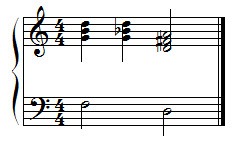In music trying to modulate from one point or chord to another or from one key to another is simply stated as a progression through chords to arrive at the desired location.
Easier said than done for those of us that haven't taken the time to understand or study the concept. There are numerous ways to get to any point through a chord progression. The following examples will help you get stated.
Strong Chord Progression Modulation
Starting with the basic idea of the circle of fifths. This states that you can move to a new chord by playing the chord a fifth away from the current chord.
The common example is a chord change from G major to C major. The fifth chord in the C system moving back to the Root Chord in the system. We would express that as V – I. It is encountered more often as a V7 – I.
 If you understand the ii7 – V7 – IM7 in playing Jazz this is a fifth change of chords in the very common progression. In the key of C that is a Dm7 minor down to G7 down to CM7.
If you understand the ii7 – V7 – IM7 in playing Jazz this is a fifth change of chords in the very common progression. In the key of C that is a Dm7 minor down to G7 down to CM7.
You would apply this chord progression by determining new new key you are going to use. Say the root of the key of A from the key of C. Using this you can work backward to say I'd like to get to A from E or from B.
So you may make a change from your current chord close to these. if you were on B diminished you might change it to a Bm7 which is the ii7 of the key of A major. This would allow you to make the direct change into the V7 (E7) and to the root (A major).
Or similarly if you were at E minor you might make a change to E7 and directly to A from that point.
Chromatic Chord Progression Modulation
Another approach that you can audition your change with is chromatic progression sequence. Lets say you wish to go to the Key of F from playing at Ab major. The sequence might look like Ab – Gm – Gb – F.
You might experiment with major and minor chords or even a diminished chord. You might try part of the harmonic system you are working in and part of the one you are where you wish to end up. Try using 7ths with each.
By experimenting with these chords you'll find things that work for you and will become natural for you to play.
Four – Four Minor – Root Modulation
 Let's look at one more that you can try. The IV – iv – I progression would work if you identified the current chord as a 4th system chord of your new key. That might mean adapting a current diminished or minor chord to a major and then using this progression.
Let's look at one more that you can try. The IV – iv – I progression would work if you identified the current chord as a 4th system chord of your new key. That might mean adapting a current diminished or minor chord to a major and then using this progression.
Starting in the key of C you may be wanting to the key of D. While playing G major you would consider this the 4th system chord of D and play G major – G minor – and then D major.
Experimenting with and Learning Modulation
You'll have noticed I'm not giving you absolutes here, it's a process of discover that you find what you like and works for you. Studying other songs is a great way to learn modulation. Don't just play the chords study the progression and chord structures. Write them out and determine what you like and don't like about them.
The following books offer a great way to study modulation. Mostly they show you how to make the changes. You have to step up and study what those chord progressions and the modulation is doing.
[asa]0786602856[/asa]
[asa]048645732X[/asa]
Check them out and then when you buy one, then dig in deep. You'll learn a lot and then start to make your own music modulations naturally.
